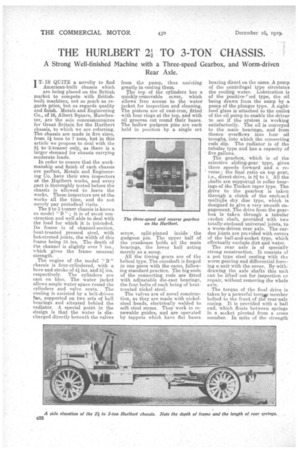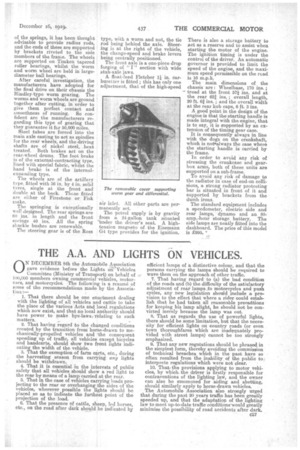THE HURLBERT 2 TO 3-TON CHASSIS.
Page 18

Page 19

If you've noticed an error in this article please click here to report it so we can fix it.
A Strong Well-finished Machine with a Three-speed Gearbox, and Worm-driven
Rear Axle.
A T% IS QUITE a novelty to find American-built chassis which are being placed on the British market to compete with Britishbuilt machines, not so much as regards price, but as regards quality and finish. Metals and Engineering Co., of 16, Albert Square, Manchester, are the sole concessionnaires for Great Britain for the Elurlbert chassis, to which we are referring. The chassis are made in five sizes, from 1 tons to 7 tons, but in this article we propose to deal with the 2i to '3-tonner only, as there is a larger demand for chassis carrying moderate loads.
In order to ensure that the workmanship and finish of each chassis are perfect, Metals and Engineering Co. have their own inspectors at the Hurlbert works, and every part is thoroughly tested before the chassis is allowed to leave the works. These inspectors are at the works all the time, and do not merely pay periodical visits.
The 2 to 3-tanner chassis is known as model " B " ; it is of stcut construction and well able to deal with the load for which it is intended. Its frame is of channel-section, heat-treated pressed steel, with hot-riveted joints, the width of this frame being 34 ins. The depth of the channel is slightly over 7 ins., which gives the frame unusual strength.
The engine of the model " B " chassis is four-cylindered, with a bore and .stroke .of 41 ins, and al ins. respectively. The cylinders are cast en bloc. The water jacket allows ample water space round the cylinders and valve seats. The cooling is assisted by a belt-driven fan, supported on two sets of ball bearings and situated behind the radiator. A -special point in the design. is that the water is discharged directly beneath the valves from the pump, thus assisting greatly in cooling them. The top of the cylinders has a quickly-removable caver, which allows free access to the water jacket for inspection and cleaning. The pistons are of cast-iron, fitted with four rings at the top, and with oil grooves cut round their bases. The hollow gudgeon pins are each held in position by a single set screw, split-pinned inside the gudgeon pin. The upper half of the crankcase holds all the main bearings, the lower half acting merely as a sump. All the timing gears are of the helical type. The camshaft is forged in one piece with the earns, following standard practice. The big ends of the connecting rods are fitted with adjustable die-cast bearings, the four bolts of each being of heattreated nickel steel.
The valves are of novel construction, as they are made with nickelsteel heads, electrically -welded to soft steel stems. They work in renewable guides, and are operated by tappets which have at bases bearing direct on the cams. A pump of the centrifugal type circulates the cooling water. Lubrication is of the positive-3ed type, the oil 'being drawn from the sump by a pump of the plunger type. A sightfeed glass is attached to the outlet of the oil pump to enable the driver to see if the system is working satisfactorily. The oil is conveyed to the main bearings., and from thence overflows into four oil troughs, into which the connecting rods dip. The radiator is of the tubular type and has a capacity of five gallons.
The gearbox, which is of the selective sliding-gear type gives. three speeds forward and a reverse ; the final ratio on top gear, i.e., direct drive, is Fit to 1. All the shafts are supported in roller bearings of the Timken taper type. The drive to the gearbox is taken through a clutch of the en-clased multi& dry . disc type, which is designed to give a very smooth engagement. The drive from the gearbox is taken through a tubular cardan shaft, provided with two totally-enclosed universal joints, to a worm-driven rear axle. The cardan joints are provided with covers of the ball-and-socket type, which effectually exclude dirt and water.
The rear axle is of specially strong construction. It consists of a pot type steel casting with the worm gearing and differential forming a unit with the cover. By withdrawing the axle shafts this unit can be lifted' out for inspection or repair, without removing the whole axle.
The torque of the final drive is taken by a powerful tom member bolted to the front of the rear-axle casing. It is provided with a ball end, which floats between springs in a socket pivoted from a cross member. In spite of the strength
of the springs, it has been thought advisable to provide radius rods, and the ends of these are supported by brackets riveted to the side members of the frame. The wheels are supported on Timken tapered roller bearings, whilst the worm and warm wheel are held in largediameter ball bearings.
After careful investigation, the manufacturers have adopted for the final drive on their chassis the Hindley-type worm gearing. The worms and worm wheels are -ground together after cutting, in order to give them perfect contact and smoothness of running. So confulent are the manufacturers regarding this type of gearing that they guarantee it for 50,000 miles.
Steel tubes are forced into the main axle casting to act as spindles for the rear wheels, and the driving shafts are of nickel steel, heat treated. Both brakes act on the rear-wheel drums. The foot. brake is of the external-contracting type, lined with special fabric, whilst the hand brake is of the internalexpanding type.
The wheels are of the artillery type; fitted with 36 in. by 4 in. solid tyres, single at the front and double at the back. Those fitted are either of Firestone or Fisk make.
The springing is exeeptionally well designed. The rear springs are 60 ins_ in length and the front snrings 40 ins. All the spring shackle bushes are renewable.
The steering gear is of the Ross type, with a worm and nut, the tie rod being behind the axle. Steering is at the right of the vehicle, the change-speed and brake levers being centrally positioned. The front axle is a one-piece drop forging of " " section with wide stub-axle jaws.
A. float-feed Fletcher 1/ in. carburetter is fitted ; this has only one adjustment, that of the high-speed air inlet. All Other parts are permanently set. •
The petrol supply is by gravity from a 24-gallon tank situated 'under the driver's seat. A hightension magneto of the Eisemann G4 type provides for the ignition.
There is also a storage battery to act as a reserve and to assist when starting the motor of the engine. The ignition timing is under the control of the driver. An automatic governor is provided to limit the speed of the engine, and the maximum speed permissible on the road is 16 m.p.h.
The main dimensions of the chassis are : Wheelbase, 170 ins. ; tread at the front 57i ins, and at the rear 62i ins. ; overall length, 20 ft. 6f ins. ; and the overall width at the rear hub caps, 6 ft. 3 ins.
A good point in the design of the engine is that the starting handle is made integral with the engine, that is to say, it is supported by an extension of the timing gear ease. It is consequently always in line with the dogs on the crankshaft, which is notsalways the case where the starting handle is carried by the frame.
In order to avoid any risk of stressing the crankcase and gearbox arms, both of these units are eupport4d on a sub-frame.
To avoid any risk of damage to the radiator in case of end-on collisions, a strong radiator protecting bar is situated in front of it and supported by brackets from the dumb irons.
The standard equipment includes a speedometer, electric side and rear lamps, dynamo and an 80a-mpahotr storage battery. The side lamps are neatly fitted into the dashboard. The price of this model is £995.


























